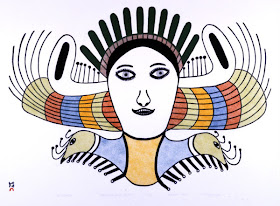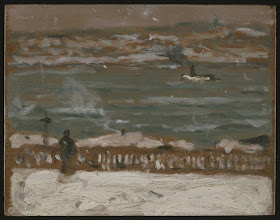James Adams
Globe and Mail Update
Published on Thursday, Jun. 03, 2010 12:25AM EDT
Last updated on Thursday, Jun. 03, 2010 12:52AM EDT
A retired investment banker from western Canada went on an unintended art buying spree in Toronto Wednesday evening, spending almost $1.6-million, excluding taxes, on just seven art works from among the 139 lots Sotheby’s Canada was auctioning at the Royal Ontario Museum.
Tom Budd, who splits his time between Calgary and Kelowna, came to Toronto initially with two bidding goals: first to buy a large oil on canvas by the Group of Seven’s Arthur Lismer called Bon Echo Rock, valued pre-sale at $250,000-$350,000, then snag an early Canadian red ensign dating to 1868, valued at $40,000-$60,000.
The 53-year-old financier succeeded in placing the winning bids on both of these lots. He got the Lismer for $778,750, including the buyer’s premium (20 per cent charged on the first $50,000 of the hammer price, 15 per cent on the balance), while the flag, which bears the coats of arms of Canada’s first four provinces, went down for $117,500. But then, “there was this other stuff going at what I thought was pretty reasonable value and, well, I just couldn’t help myself,” he said in a brief interview afterwards.
Sotheby’s was pleased by his lack of restraint. By dollar value, Mr. Budd’s purchases accounted for more than 20 per cent of the approximately $7.4-million the auctioneer earned in total from its live sale. Going into the auction, Sotheby’s estimated its consignments could fetch between $5.5-million and $8-million if they all sold. At evening’s end, about 22 per cent of the 139 lots were declared unsold.
Besides the Lismer and the flag, Mr. Budd purchased two landscapes by another Group of Seven alumnus J.E.H. MacDonald (for $36,000 and $94,500), a small Tom Thomson oil sketch (for $462,500), another Lismer (for $36,000), another Group of Seven oil, this one by A.Y. Jackson ($57,000).
Until this week, Mr. Budd had only one piece of fine Canadian art in his home, a Tom Thomson sketch called Dawn on Round Lake, purchased in April last year from a Calgary auction house. That buy made headlines across the country after the auctioneer initially refused to accept Mr. Budd’s bid of $350,000 as a sale. Apparently, the reserve for the painting – the secret price auctioneer and consignor agree beforehand will be the minimal acceptable sale value – was around $400,000. A shouting match ensued, with Mr. Budd storming out of the sale room. Eventually, a deal was reached after the auctioneer consulted with the elderly woman who’d consigned the piece.
Since then Mr. Budd has done “a little more research, a little more reading” on Tom Thomson and the Group of Seven. Now he hopes “to build a small collection of their works” that his children can inherit one day or perhaps donate to a gallery or museum. Previously, Mr. Budd collected wine and cars. Indeed, he bought his first Thomson in Calgary mostly on a whim, after a rain storm shortened a car race in which he was involved. Otherwise, he would have missed the sale.
The same sort of whimsy also played into his purchase of the red ensign Wednesday. Last month he read a newspaper article describing the hand-made, 129 cm-by-214-cm flag as the first one made following the Confederation of Canada in 1867. “I thought it was just really neat that there was such a thing and I thought I’d like to own it and donate it to an institution.”
Other non-Budd works that performed well for Sotheby’s were an Emily Carr canvas from the 1930s, Sunlight in the Forest, that fetched $750,000 and an untitled 1960 abstract by Quebec master Marcelle Ferron, which sold for $485,000 – almost twice the high-end of its pre-sale estimate of $250,000 and more than double the previous auction record of $209,500. A small autumn sketch, Montreal River, Algoma, completed in 1918 by Group of Seven founder Lawren Harris sold to a telephone bidder for $301,500 – far above its $125,000-$175,000 estimate.
Extracted from the Globe and Mail. To see the article on the Globe's website please click here.





























